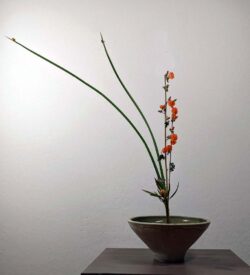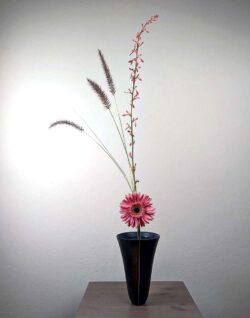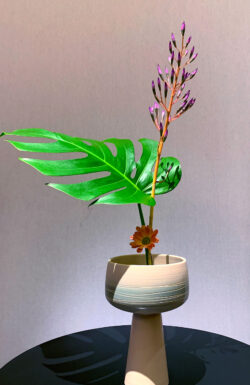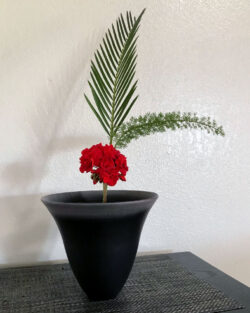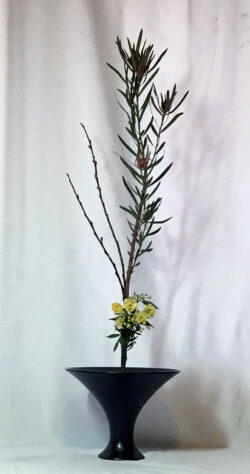Sensei engaged us with a thoughtful, patient approach as he and Brenda Jackson explained the various styles we are learning about. Their deep and broad knowledge of Ikebana shone through as they explained and critiqued our arrangements.
Shoka Shimputai was first introduced in 1977 by our present Headmaster Sensei Ikenobo, to incorporate his new ideas from his own practice. He felt this new style would allow him to express the inspiration he received from the plant material without relying on previous models. The primary objective of the announcement of Shoka Shimputai was to liberate Shoka from the strictures of the Tokonoma. In the same way as FreeStyle, Shoka could now be arranged in a variety of spaces.
Shimputai moves away from the general conception of the plants that are its materials, and instead, focuses on individual components of plants, such as the shape, color, and texture. This creates a new beauty in Shoka that had not been expressed previously. For this reason, the combination of flowers and other plants is very important. The Shimputai arranger does not merely select plants: the plants selected must express the arranger’s intention.
Shimputai follows the traditional arrangement style, using three 3 important attributes:
Brightness, Sharpness, and Distinctiveness – To establish these attributes consider:
1. Unexpectedness – the materials give you an unexpected image, you feel affected (color, texture, etc.) Combine different types of materials that are usually not used together. Example: Japanese materials with Western materials (i.e. Japanese Pine with Western Rose); and materials not found in the market or flower shop.
2. Contrast – use two kinds of materials that bring out each other’s characteristics, (i.e. bright and dark, big and small, thick and soft, long and short, woody and grassy).
3. Proof of Life – follow the “changing of the seasons,” the plants growing and life going away. The plants must have life – this is the most important thing. Show the brightness of life in each process of the plants. Use modern materials among standard plants.
Shoka Shimputai TIPS:
- Shoka Shimputai has two main parts, Shu and Yo
- Shu is the material you most want to arrange, the material that captures your heart
- Yo responds to Shu, compliments the Shu
- Ashirai are added if needed
- Okay to cross lines, “but take care in doing it,” turn materials (directionally)
- Have a clean appearance, have focus, do not confuse the arrangement, give space
- Show movement, motion, watch for orientation, tilt or turn stems to change shape & color
- Shu should be the “most beautiful” material, highlight Shu
- Brighten up the mizugiwa at the water’s edge
- Show color contrast in materials and create a “natural feeling,” by using different lengths in stems
- Show expression in the movement, show shusso – reconfigure the materials (curves)
- Don’t be too balanced or static, use straight and curved lines, jump Yo to Shu
- Don’t make mizugiwa too strong
- Show interesting movement in stems but be careful the movement is not peculiar or unnatural
- Emphasis on the characteristics of the flowers more than on traditional Shoka Shofutai
- Mizugiwa (waterline) must be tight, often lower than traditional
- Sashiguchi (stems) must “fan-out”
- Ashirai is used for balance (not symmetry), to anchor the base, to show the season, to amplify movement or add a touch of color


